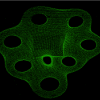Hi there,
I would like to know more about pathtracing because I would like to integrate this rendering method inside Unity but I absolutely don't know how to begin.
I would be glad to read your advices, whitepapers, code, examples, etc. or anything that might help me and have some guidelines that might show me the right direction to integrate this rendering method and pipeline.
There are some people that did this but I don't know how they did that. I have some knowledge in graphic programming but consider that I am a beginner.
Thank you very much for your help.





